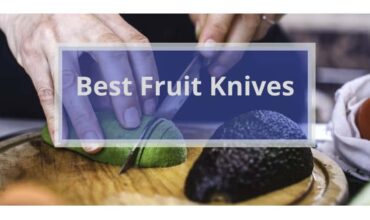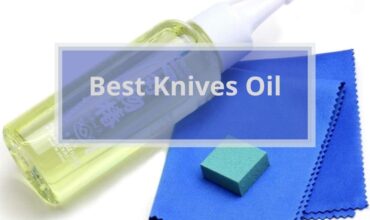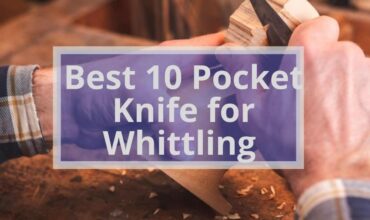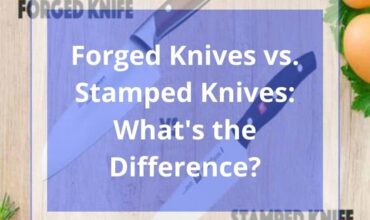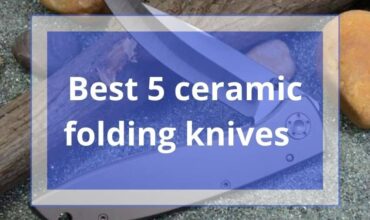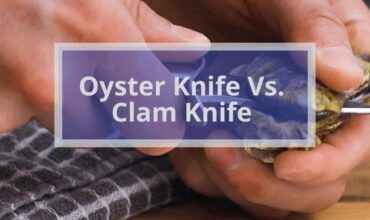In the cutlery world, there are two main multifunctional types of chef’s knives in the kitchen: the Japanese kitchen Santoku knife and the Western chef’s knife.
An untrained eye can confuse them as one type. But in fact, they have many differences ranging from designs and shapes to cutting styles and techniques.
Santoku Knife Overview
Santoku knives originate from Asian cuisine. They represent the Japanese version of the chefs’. The santoku blade shape is different than the western style chef’s knife.
Particularly along one side of the entire sword length and have a slight curve of CMS on the edge’s top tip. Moreover, the santoku is very popular for its lightweight. And short length compared to the European.
The method when using a santoku knife is different from the chef’s. You should hold the knife handle of the santoku and cut with moving forward and backward.
Yet, with every cut. You must make sure that the blade does not touch the cutting board. Using the santoku is very straightforward. All you need is to practice a lot, and you will get the hang of it.
Chef’s Knife Overview
The western style chef’s knife (aka cook’s knife) is always produced in both Germany and France.
It is the perfect choice for cutting and chopping beef, fish, vegetables, and herbs. it should be used by rocking the blade forwarding and backward. During this. the chef knife tip should not leave the cutting board.
The chef knife blade has a round shape line. And they usually come in 20cm in length. Yet, there are smaller chef’s knives with a sword length of 16cm.
Santoku Knife Features
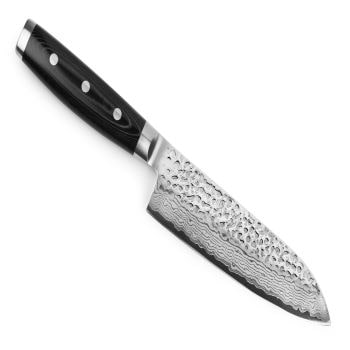
Blade
- The “three uses” knives come with a wide sheepsfoot blade without any presence of a tip.
- It features a straight edge as well as a spine that bends down to meet it at the point of the blade. reducing the chances of puncturing the food, giving you a clean slicing.
- The santoku blade is a so much thinner blade than the chef’s one. making these knives ideal forused mainly for refined slicing.
- They are available in a single bevel and double bevel models.
- It options a short blade from 5 to 7.9 inches long. derived from the Nakiri design, which is chunky.
- Santoku knife is manufactured from Japanese steel. Which makes it heavier with an elegant and heavy feel. That makes it ideal to chop with.
Bolster
- Santoku knives have no bolster. which many consider as a drawback as bolster is like a finger guard for your safety.
- However, they come with a perfect balance so that you can hold them easily and effortlessly.
- A santoku knife is usually lightweight as it is so thin blade. and the blade usually ranges from 5 to 7.9- inch.
- Cleaning a santoku knife is so effortless, as most of them come with a Granton edge that prevents your food from sticking into the edge.
Read more , How to shuck oysters without an oyster knife
Chef’s knife Features
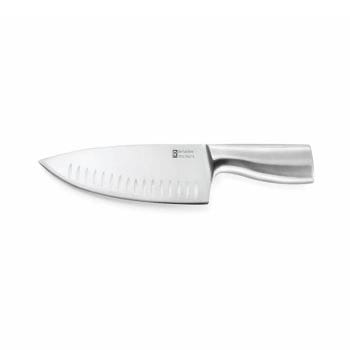
Blade
- It has a long blade length from 8-12 inches long as the long sword is easier to slice with one single stroke.
- The German version comes with a blade that has a curved blade tip. This assures you have more control. And stability while employing the rocking technique.
- While the French knife version comes with a sword that is straight with a more triangular tip at the front. This gives it the ability to for smoother slicing, especially for meat.
- The multi purpose knife chef blade material derived from combing the blacksmith crafting. In both the east and west.
Bolster
- The chef knife options a bolster that provides the expert cooks with a better grip and control of the kitchen knife.
You may also like The Anatomy of a Kitchen Knife Buyer’s Review
How Are a Santoku and Chef Knife Different?
-Santoku knives are usually Japanese, while chef’s knives are german or french
-Chef’s knives are heavier in weight.
-Chef’s knives feature bolster while santoku knives don’t.
-The bevel is mainly double in the western knife, while it can be single or double in the santoku. (The difference in bevel changes the angle in the sharpening process.)
-Santoku knife isn’t suitable for the rocking motion technique as the chef’s knife. instead, you chop your food down in just one single motion.
How Are a Santoku and Chef Knife Similar?
Here are the common features between the Santoku and the chef’s knife.
-Both of them are general-objectives knives and not specialized ones, unlike the special knives for cutting meat as the carving, boning, or trimming knives.
-You can use them in multi-uses that range from cutting, chopping to dicing, and mincing.
-As for the materials, you will find the standard materials in both of them, either ceramic or metal. Some go with steel, as it is more durable and corrosion-resistance. Both of them are general-objectives knives and not specialized ones, unlike the special knives for cutting meat as carving, boning, or trimming knives.
-You can use them in multi-uses that range from cutting, chopping to dicing, and mincing.
-As for the materials, you will find the standard materials in both of them, either ceramic or metal. Some go with steel, as it is more durable and corrosion-resistance.
Also check, What are the Benefits of Oysters? | 7 Healthy Advantages
The Best Uses for a Santoku Knife
What the sankotu knife used for?
Slicing
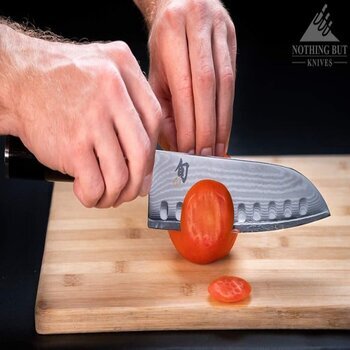
The sankotu knife comes with a flatter along the blade’s length with a small, curved top on the cutting edge. offering smoother slicing. However, it cannot handle the rocking motion technique.
As the sankotu knife requires lifting the entire knife blade off the cutting board. This is slower than European styles. Because it must be treated with extra care to create thin slices.
Dicing
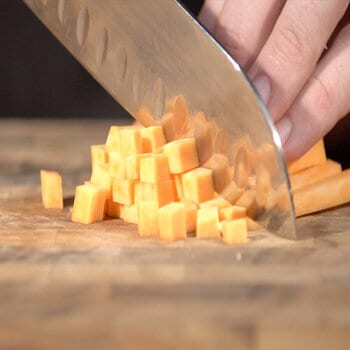
The santoku is the best kitchen knife choice for precision like dicing. because of its small and flexible sword size.
Most santoku knives come with an angle between 10 to 15 levels. Making them more suitable for dicing with more accuracy than those with broad swords.
Read More: https://kitchenzad.com/best-bread-knife/
Chopping
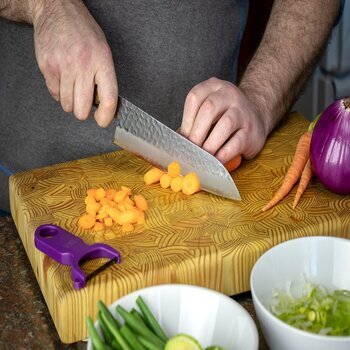
Santoku features a very snappy sword. offering a quick, and consistent cutting. they contact the cutting board at multiple points at the same time.
A santoku knife may be faster in chopping than chef knives. As it is more flexible and can move faster.
Also read , How to Hone Your Knife? | Easy Guide
The Best Uses for a Chef’s Knife
Thanks to the flexibility of this kitchen knife, it can tackle lots of your kitchen tasks perfectly. It will act as one of your best bread knives to cut your homemade baguette just as the noble Frenchmen.
Choose any favorite type of cheese, whether cheddar, mozzarella, or even parmesan, and cut it easily with the western chef’s knife.
The Differences in Caring for a Santoku and Chef’s Knife
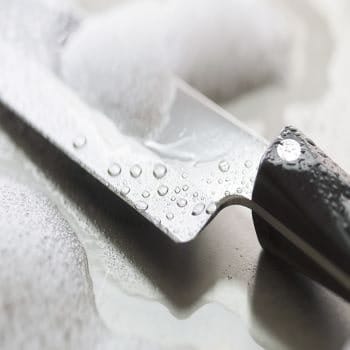
If you maintain your kitchen knife properly through cleaning, storing, and sharpening, you will get a sharp blade knife for years to come
Handing washing is recommended in whichever of the two knives. Exposing these knives to the high pressure of the dishwasher will lead to their damage.
Make sure that you dry them thoroughly after washing and keep them in a dry place to avoid any rust or stain in the long term.
Read More: https://kitchenzad.com/different-types-of-kitchen-knives-and-their-uses/
Read more , How to Care for Your Paring Knife?
Santoku Knife Sharpening
The main purpose of sharpening is in restoring the sharpness of the knife blade that locates at the angle. And due to the absence of a bolster, it is always easier to sharpen a Santoku knife, unlike the chef’s one that may use a bit more effort.
You can use an electric knife sharpener or a manual knife sharpener for this process. but if you can’t afford them, you better go for the whetstone knife sharpener, it will never let you down! here is how to sharpen your santoku with a whetstone in brief.
Tools
- Whetstone
- Water
- Towel
Steps
- Soak the stone for 45 mins.
- Adjust the coarse side.
- Slide your knife on the stone.
- Sharpen the whole knife.
- Repeat the process.
- Swipe to the finer stone to give a mirror polish to the knife.
- Wash the knife with soapy water.
Sharpening the chef’s knife
For a chef’s knife start with a minimum of 15 reaching 20 angle degrees for the two sides of the kitchen knife. And unlike the Santoku knives, you can use a sharpening steel rod for the honing part, as the blade shape is much thicker in this one.
Here is how to hone your knife using a honing steel.
Tools
- Sharpening steel rod
- chef’s knife
Steps
- Hold both the knife and the steel.
- Place the bottom of the knife blade against the rod for an approximately 3 cm.
- Make a medium force by pulling the knife against the sharpening rod until you reach the tip of the knife blade.
- Repeat this process from 5 to 10 times until you get a sharp cutting edge for your blade.
Read More: https://kitchenzad.com/the-anatomy-of-a-kitchen-knife/
Check also, 10 Best Bread Knife 2022 Review
What is the Best Way to Store a Santoku and Chef’s Knife?
Here are the four main techniques for storing them
Magnetic strip.
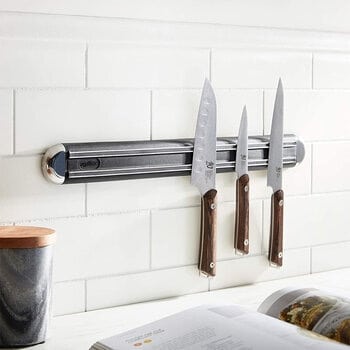
You can stick the magnetic strip next to the kitchen sink or under the cabinet. It is a convenient and brilliant way for a tight kitchen space. The magnetic strip is easy to clean. And does not affect the sharpness or the spiral of the blade.
Knife block and docks.

a knife block and dock is an accessible way to store your tools on the kitchen counter. They keep your blades closer to your working station.
However, they can damage very snappy Japanese knife blades. As they need to be straight vertical, which requires more friction when pulling out of the block.
Drawer holder
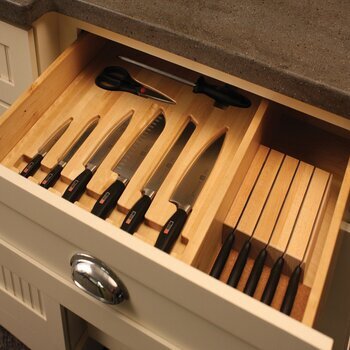
Keeping your sankotu in a drawer holder is one of the ways to store them. but you need to pay attention while pulling them out of the drawer otherwise, you might get yourself injured.
Sheaths
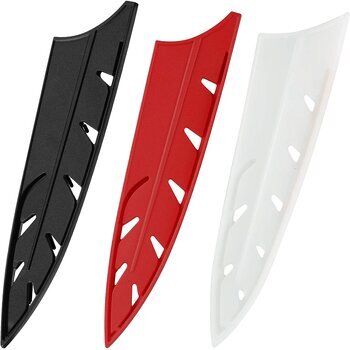
It is a convenient way to take your knives on picnics. and a very useful way to keep your tools in your bag. However, they are very hard to clean from the inside.
Read also , Things to Consider When Buying an Electric Knife Sharpener
What is the best size for the santoku knife?
The best santoku knife sizes are those 7 inches long. This facilitates the preparation for people. With inconsistent hand size, a culinary student or a home cook who is still not an expert in using professional chef’s knives.
